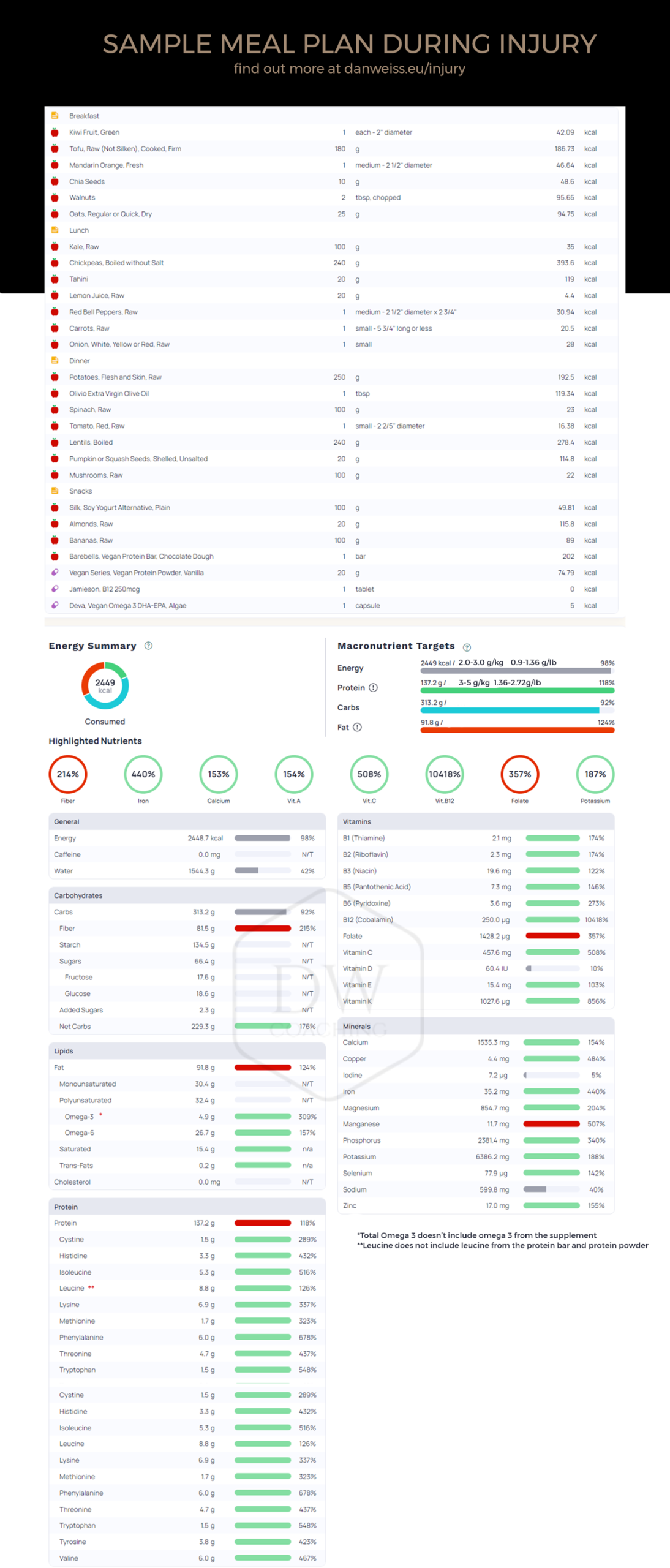How to Eat to Recover Fast from Injury and Illness
When it comes to injury recovery, nutrition is a useful tool that is often overlooked. Do you know that the energy demands of the body increase during injury and illness? Which vitamins and minerals are essential for faster recovery?
Adequate energy intake and proper nutrition during the treatment of illness and injury can help maintain muscle mass and speed recovery.
In this guide you will find:
- How to prevent disease with nutrition
- What to eat if you get sick or injured
- Nutrition after surgery
- Calculator for calculating energy intake during illness and injury
- How to reduce losing muscle mass
- Sample meal plan
Food and optimal functioning of the organism
Proper nutrition allows our body to function better. If our body is attacked by viruses or bacteria, it can deal with them faster and more effectively if it has all the nutrients it needs. If there is physical damage to the tissues, such as during operations and injuries, it can regenerate faster.
In order for our body to function optimally, it needs energy, building materials (amino acids), vitamins, minerals, and essential fatty acids.
The immune system
The immune system, when working properly, protects us from bacteria, infections, and viruses.
It consists of several lines of defense. Our digestive tract makes up 70% of the immune system.
Everything we put in the mouth, including food, will trigger a reaction from the immune system, because even food poses a potential risk. In the case of food allergies, we can observe an exaggerated reaction of the body to the ingestion of food.
Another line of defense is the stomach. Hydrochloric acid kills most bacteria before they reach the small intestine.
If the bacteria get deeper, we have proteins and chemicals that are activated.
We even have help in the form of bacteria in the small intestine, which prevent unwanted bacteria from entering the bloodstream or settling in the small intestine. The food we eat directly affects the composition of these bacteria in the small intestine and thus also our immune system. Therefore, a varied diet rich in fiber is beneficial for us, while a diet full of industrially processed foods, added sugars and fats is not beneficial.
- Continuous overeating or eating more than the body needs can compromise the immune system’s response to invaders. Excessive energy intake (overeating) leads to an increased level of inflammation in the body. A lot of it has to do with the fats we eat. These become part of cell membranes and affect how cells react to invaders. Unhealthy fats thus disrupt immune functions.
- A large drop in energy can weaken the immune system. This may explain why many people get sick a week after starting a crash diet.
- Low energy intake leads to a low intake of micronutrients.
Energy intake
If we are sick or injured, we have reduced physical activity. But athletes often don’t realize that even if they don’t move as much, their body spends increased energy on healing itself. This applies to physical damage (fractures, damage to tendons, operations), but also to illness. If you reduce energy intake too much, you risk muscle wasting and prolonged treatment time.
Let’s see how much energy an athlete needs during treatment
A healthy athlete needs energy that covers:
- basal metabolism
- normal daily activities
- sport activities
- in the case of trying to build muscles and energy for building muscle mass
During illness and treatment, it is stress associated with fever or wound healing.
Activity coefficient:
Sedentary: minimal or no movement (approx. up to 5000 steps per day) 1.2
Light activity: training 1 to 3 times a week or approx. 5000 steps per day 1.375
Moderate activity: training 3 to 5 times a week or approx. 7500 steps per day 1.55
Very active: training 6 to 7 times a week or approx. 12500 steps per day 1.725
Extra Active: very intense daily training or physically demanding work 1.9
*Estimating your activity coefficient is often difficult. Training is easy to quantify, but normal daily activities must also be taken into account. My experience shows that ordinary people overestimate their activity, while those who are devoted to sports underestimate it.
Temperature factor:
38°C: 1.1
39°C: 1.2
40°C: 1.3
41°C: 1.4
Damage factor
Small injury (sprained ankle, dislocation) 1.2
Small surgery (removal of birthmarks, fracture): 1.2
Multiple fractures: 1.2-1.35
Infected wound: 1.5
Serious trauma (ACL surgery): 1.5
Burns
- up to 20%: 1.0 – 1.5
- up to 40%: 1.5 – 1.85
- Above 40%: 1.85 – 2.05
Examples:
You can use the TDEE calculator above to calculate energy intake (resting metabolism + activity factor).
Example: 30-year-old man, 70 kg, 178 cm, during the treatment of a sprained ankle:
Resting metabolic rate: 1887kcal
Sedentary: 1.2
Stress factor: 1.2
1887*1.2*1.2 = 2717.28 kcal
Example: 20-year-old woman, 59 kg, 162 cm, with anterior cruciate ligament tear:
Resting metabolic rate: 1568kcal
Sedentary: 1.2
Stress factor: 1.5
1568*1.2*1.5 = 2822.4 kcal
How to supply the body with energy during treatment
Proteins
During injuries and immobilization, protein breakdown takes place at an increased rate. In order to suppress this decomposition, it is necessary to increase the intake of proteins and take into account their quality.
It is recommended to take 2.0-3.0 g/kg of protein.
Not all protein sources have the same amino acid composition. While under normal conditions this is not a problem, during injuries and extended time without movement it is good to consider their quality as well. Specifically, the amino acid leucine gives the body a signal that triggers protein synthesis (the creation of proteins). It is recommended to take at least 2g of leucine in one dose, for people over 50 it can be up to 3g.
Foods rich in leucine are:
- 1% cottage cheese (1 cup): 163 kcal, 28 g protein, 2.9 g leucine;
- chicken breast without skin (about 120g): 188 kcal, 36 g protein, 2.7 g leucine;
- one serving of whey protein isolate (27 g): 100 kcal, 23 g protein, 2.5 g leucine;
- canned tuna (90g): 109 kcal, 28 g protein, 1.6 g leucine;
- black beans (1 cup): 218 kcal, 15 g protein, 1.2 g leucine;
- wheat gluten (50g) 185kcal, 2.7g leucine;
- tofu (1/2 cup): 98 kcal, 11 g protein, 1 g leucine;
- cooked oatmeal (1 cup): 166 kcal, 6 g protein, 0.5 g leucine
Carbohydrates:
Complex carbohydrates (whole grains, fruits, vegetables) should form the basic component of energy during treatment. They play a role in immunity, hormones and enzymatic processes and contain the necessary vitamins, minerals and fiber. They have a protective function during catabolic processes (breakdown of proteins). Compared to simple sugars, energy from them is released for a longer time, so they satiate for a longer time and provide the body with glucose.
Essential fatty acids:
In the initial stages of an injury, inflammation is created in the body, which is necessary for healing. However, long-lasting inflammation in the body slows down treatments and is associated with overall poorer health. Focus mainly on omega 3 fatty acids (2g/day)
Good sources are crushed flax seeds, walnuts, hemp seeds, fish, and nutritional supplements.
Avoid fatty, fried foods, and vegetable oils that are rich in omega 6 fatty acids. These support inflammatory processes in the body, as long as we take them in an increased amount – which is normal with a normal diet.
Food quality
Food quality also plays a role. For example, farmed fish are fed corn, soy and fast growth feed, which affects their fat composition.
So, while free-swimming fish can be rich in Omega 3 acids, farmed fish are rather the opposite. Nuts are a good source of Omega 3, store-bought nut oil probably not.
Vitamins and minerals
During an injury, we want to support the body and supply it with all the necessary substances. This also includes vitamins and minerals, especially vitamins A, C, and E.
Vitamins C and A are involved in the formation and storage of collagen, and vitamin E is an antioxidant. Omega 3 helps in the fight against inflammatory processes (which are not bad, but we usually have too little omega 3 in our diet).
Vit. C (kiwi, grapefruit, orange, broccoli, cabbage),
Vit. A (sweet potato, carrot, spinach, pumpkin, liver)
Vit. E (sunflower seeds, almonds, spinach, avocado)
Calcium
Calcium is involved in bone structure. Athletes should have 1000mg of calcium in their diet. Good sources are kale, chia seeds, calcium-fortified soy products, canned fish with bones, eggshells, milk and dairy products.
Vitamin D
The vitamin is necessary for the incorporation of calcium into the bones. It also contributes to immunity. You can get most of it from sunlight, but the sunlight intensity might not be enough during winter months for our body to produce it. Therefore, it is advisable to supplement it from autumn to spring if you don§t live by the equator.
HMB
HMB is a nutritional supplement that is a metabolite of leucine. It is used in medicine because of its strong effect on protein synthesis in elderly people who do not have sufficient protein intake or when they stay in bed for a long time.
In principle, it greatly helps to reduce the loss of muscle mass during immobilization.
Doses of 3 g per day divided into 1.5 g doses have shown the most effective results for muscle maintenance.

To eat or not to eat?
On the one hand, food provides us with the nutrients needed for a faster recovery, on the other hand, it may not taste good at all during illness. We can even come across opinions that it is better to fast and not eat at all.
This recommendation was based on the fact that when we do not take food, our body can “clean up”. It destroys cells that are sick (apoptosis) and repairs damaged cells (autophagy).
Limiting energy intake can improve cell immunity and the overall health of the organism, on the other hand, it reduces our immunity.
So what to do?
The best advice is to follow your appetite during illness. You won’t have an appetite during a fever, but your appetite probably won’t suffer when you have a cold. However, if you have no appetite, I recommend that you at least focus on taking vitamins in the form of supplements.
Sources
Smith-Ryan AE, Hirsch KR, Saylor HE, Gould LM, Blue MNM. Nutritional Considerations and Strategies to Facilitate Injury Recovery and Rehabilitation. J Athl Train. 2020;55(9):918-930. doi:10.4085/1062-6050-550-19
